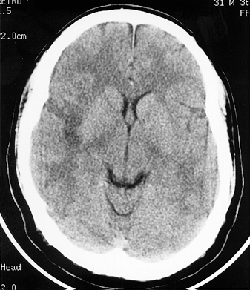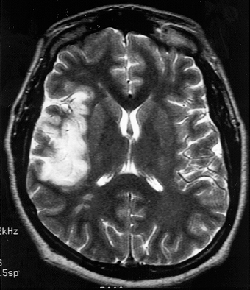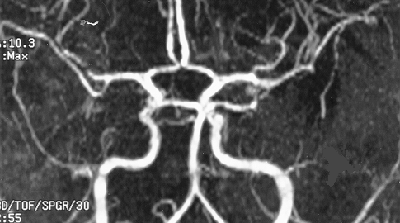The patient is a 32 year old right-handed male with a previous admission three months prior to this hospitalization. At that time, he presented with a right frontal headache, a mild left facial droop, and left hemiparesis with the arm more affected than the leg. A CT scan of the head without contrast was done approximately 10 hours after the initial symptoms.

CT of the head without contrast (performed 10 hours after initial symptoms).
A MRI of the brain with and without contrast and a MRA was performed three days following admission. Blood cultures, urine toxicology screens, and laboratory stroke profile tests were normal. A lumbar puncture revealed a WBC of 31 with a differential of 6% neutrophils, 82% lymphocytes, and 11% monocytes; RBC 10; protein 27; glucose 67; and all CSF cultures negative. The patient's hemiparesis improved and he was placed on medication and discharged to home with plans for follow-up in the clinic.

MRI of the brain with and without contrast was obtained. Only the T2 weighted image is illustrated for your diagnostic interpretation.

MR angio (MRA) of the head and neck.
His brother reported that the patient had some mild difficulty with memory, most noticeably over the last several months. The family also related behavioral changes, which they characterized as increased irritability and impulsiveness. He denied palpitations, difficulty breathing, weight loss, fever, night sweats, joint pains, muscle pains, rash, and bowel or bladder incontinence.
The patient had no history of hypertension, diabetes, bleeding difficulty, or cardiac problems. There was no significant family history. He smoked one half pack of cigarettes per day for 11 years, and he occasionally drank alcohol in moderation. He denied drug abuse and HIV risk factors. His only medication was ASA, 325 mg which be began taking three months ago.
Vital Signs: Temperature: 98.9; Blood Pressure: 135/70; Heart Rate: 78; Respiration: 14.
The general physical examination was within normal limits. Pertinent signs included a supple neck with full range of motion and absence of lymphadenopathy, cardiac murmurs, and joint or skin abnormalities.
Mental Status: The patient was awake, alert, and oriented with a mini-mental status score of 29/30. He missed one for recall. His speech was fluent and he had good naming repetition and comprehension without dysarthria.
Cranial Nerves:
Cranial Nerves | Findings |
|---|---|
| I | Not tested |
| II | Right homonymous hemianopsia. Normal pupillary function. Normal fundoscopic examination. |
| III / IV / VI | Extraocular movements were intact without nystagmus. |
| V | Intact sensation in all divisions. Intact motor strength in masseter and temporalis. |
| VII | Intact muscles of facial expression without asymmetry. |
| VIII-XII | Intact. |
Motor: Normal bulk and tone without fasciculations, except for the lower extremities which had slight increase in tone. There was no pronator drift. Muscle strength was 5/5 throughout.
Reflexes: Reflexes were 3/4 at the biceps, triceps, brachioradialis, and quadriceps. Reflexes at the ankles were 4 with several beats of unsustained clonus. Plantars were down-going bilaterally. Both a Hoffman's and a jaw jerk were present.
Sensation: Pinprick, light touch, vibration, and proprioception were all intact.
Cerebellar: Rapid alternating movements, finger-nose-finger, and heel-to-shin were performed without evidence of dysmetria or dysdiadochokinesia.
Gait: The gait demonstrated a normal base and arm swing. He was able to toe, heel, and tandem walk without difficulty.
Email comments: